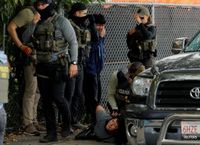Federal agents in riot gear pacing the rooftops, a mother thrown to the ground in front of her crying son, and a pregnant woman waiting in anguish by her husband’s hospital bed—these are the raw, human images emerging from a week of escalating immigration enforcement and violence across the United States. As President Donald Trump’s administration intensifies its efforts to deport record numbers of immigrants, major cities are seeing a surge in both official crackdowns and public backlash, according to reporting from Reuters, NPR, and other news outlets.
The latest flashpoints began on September 24, 2025, when a gunman targeted an Immigration and Customs Enforcement (ICE) field office in Dallas, Texas. FBI Director Kash Patel told the public that the shooter, 29-year-old Joshua Jahn, had carefully plotted his attack, even leaving behind a chilling note: “Hopefully this will give ICE agents real terror, to think, ‘is there a sniper with AP [armor piercing] rounds on that roof?’” Despite Jahn’s stated intent to strike fear into federal agents, it was three detainees—Norlan Guzman Fuentes, Jose Andres Bordones-Molina, and Miguel Angel Garcia-Hernandez—who became the victims. Fuentes, originally from El Salvador, was killed; Bordones-Molina, from Venezuela, and Garcia-Hernandez, from Mexico, were left critically wounded. Jahn took his own life after the attack.
For Stephany Gauffeny, the violence is more than a headline. As she sat in a Dallas law office, rubbing her pregnant belly, Gauffeny told NPR about her husband, Garcia-Hernandez, who remains on life support after being shot. “It hurts to think like, what if he never even gets to meet him,” she said, referring to their unborn child. Garcia-Hernandez, detained since August for driving under the influence, had lived in the U.S. since his teens and was seeking permanent residency through his U.S. citizen wife. Now, Gauffeny spends her days at Parkland Memorial Hospital, where her husband is shackled to his bed despite being unconscious. ICE agents tightly control access to his room, making it difficult for family members to visit.
“Before he got arrested … he had told me, ‘Okay, my next paycheck, you know, we’re gonna go out and buy the baby all this stuff,’” Gauffeny recalled. “And, you know, it never happened.” With Garcia-Hernandez the family’s main provider, Gauffeny and their four children—aged 3, 8, 12, and 14—now rely on a GoFundMe campaign to cover groceries and bills.
While the Dallas shooting sent shockwaves through immigrant communities, it’s only one facet of the broader crackdown. On September 25 and 26, 2025, aggressive ICE enforcement actions played out in New York City, Boston, Chicago, and other major cities. In Chelsea, Massachusetts, federal agents—including U.S. Marshals, FBI, and Homeland Security Investigations—detained a woman during a raid. Though she was later released at the scene after being identified as a legal U.S. resident and taken to the hospital for evaluation, the episode left deep scars. Milagros Barreto, a worker advocate with La Colaborativa, told Reuters she witnessed agents throw a Guatemalan woman named Hilda to the ground, pinning her hands behind her back as her son looked on in tears. Barreto said Hilda aggravated a pre-existing back injury and suffered shoulder scratches, requiring hospitalization. “It doesn’t matter where you come from. If you look like a Latino, you’re a target,” Barreto said.
Such stories have become increasingly common as Trump’s administration shifts its focus from targeting only those with criminal records to arresting many immigrants without them. The President’s push is billed as a crackdown on crime, but the reality on the ground, according to local advocates and residents interviewed by Reuters and BROADVIEW, is far more sweeping. In Democrat-leaning cities like New York, Chicago, and Washington, residents and officials have pushed back, staging near-daily protests and calling for the closure of detention centers.
Some Hispanic residents allege they are being stopped solely because of their appearance—allegations the Trump administration denies. Yet, earlier in September, the Supreme Court lifted a lower court injunction that had previously restricted ICE from stopping people based solely on ethnicity, language, or similar factors in the Los Angeles area. This legal shift has heightened anxiety in immigrant communities, with many fearing they could be targeted simply for the way they look or speak.
California Governor Gavin Newsom recently signed legislation barring ICE officers from wearing masks to conceal their identities, a move aimed at increasing accountability. Critics of masked enforcement say it prevents the public from holding officers responsible for misconduct. Trump officials, however, argue that masks are necessary to protect officers from becoming targets themselves.
The tension boiled over in Broadview, Illinois, on September 26, when ICE agents used tear gas, less-lethal rounds, flash bang grenades, and pepper balls to disperse protesters outside a detention center. Reverend Beth Brown, a pastor at Lincoln Park Presbyterian Church, described the scene to Reuters: “People were peacefully standing behind the fence and for absolutely no reason, pepper balls were fired.” The Department of Homeland Security countered in a statement that “over 200 rioters” blocked access to a facility gate and that 30 “swarmed another gate” in an attempt to enter the property.
Meanwhile, in New York City, a video posted by ProPublica showed an ICE officer charging at Monica Moreta-Galarza, an Ecuadorian asylum seeker, in a courthouse hallway as she pleaded for her husband not to be taken away. In a rare move, Department of Homeland Security spokesperson Tricia McLaughlin announced the officer had been “relieved of current duties” pending an investigation. “The officer’s conduct in this video is unacceptable and beneath the men and women of ICE,” McLaughlin said.
Oversight of such incidents has become more difficult in recent years. The Department of Homeland Security’s office responsible for investigating civil rights violations by personnel was largely gutted at the start of Trump’s administration, according to Reuters. This has left many advocates and community leaders concerned about accountability as enforcement intensifies.
Back in Dallas, the aftermath of the ICE facility shooting continues to reverberate. Family members of the victims, like Gauffeny, are left searching for answers and support, while officials grapple with the question of how to prevent further violence. The shooter’s stated goal may have been to terrorize federal agents, but the toll has fallen most heavily on the detainees and their families—those already caught in the crosshairs of a deeply contentious national debate.
As the nation watches, the stories of Hilda in Chelsea, Gauffeny in Dallas, and countless others serve as stark reminders of the human cost at the heart of America’s immigration battles.

